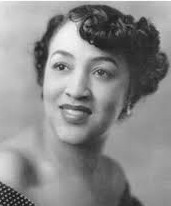Mary Kenner facts for kids
Quick facts for kids
Mary Beatrice Davidson Kenner
|
|
|---|---|
 |
|
| Born | May 17, 1912 Monroe, North Carolina, U.S.
|
| Died | January 13, 2006 (aged 93) Washington, D.C., U.S. |
| Nationality | United States of America |
| Occupation | Florist |
| Known for | singing, inventions |
| Parent(s) | Sidney Nathaniel Davidson |
| Relatives | Mildred Davidson Austin Smith |
Mary Beatrice Davidson Kenner (May 17, 1912 – January 13, 2006) was an amazing African American inventor. She received five patents during her lifetime. This means she officially owned the rights to five of her inventions. She holds the record for the most patents given to a Black woman by the U.S. government.
Kenner's first and most famous patent was in 1957. It was for the sanitary belt. This invention was a very early version of today's sanitary pads. She actually thought of the belt 30 years earlier, in the 1920s. However, she could not afford to get a patent then. She also faced unfair treatment because of her race when she tried to sell her product.
Her other four patents included a sanitary belt with a special pocket to stop leaks. She also invented a toilet paper holder. Another invention was a tray and pocket that could attach to wheelchairs or walkers. Her last patent was for a back washer and massager that could be mounted on a wall.
Contents
A Family of Inventors
Kenner was born on May 17, 1912, in Monroe, North Carolina. She grew up in a family full of inventors. Her father, Sidney Nathaniel Davidson, invented a small, portable clothing presser. Her grandfather, Robert Phromeberger, invented a special three-color light for signaling trains. He also created a stretcher on wheels for ambulances.
Her sister, Mildred Davidson Austin Smith, also became an inventor. In the 1980s, she patented a board game called Family Treedition. This family interest in creating new things inspired Kenner from a very young age. When she was just 6 years old, she tried to invent a door hinge that could oil itself. As a child, she also created a portable ashtray for cigarette packs. She even thought of adding a sponge to the tip of an umbrella to soak up rainwater.
Education and Work
Kenner finished Dunbar High School in 1931. She then got into Howard University. She studied there for about a year and a half. But she had to leave due to money problems and unfair treatment because she was a woman.
After leaving school, she took on many different jobs. In 1941, she started working for the government. She continued this work for ten years. In 1950, she became a professional florist. She ran her own flower shop until the 1970s. All this time, she kept inventing things in her free time.
Amazing Inventions and Lasting Impact
Mary Kenner created many inventions and received several patents. Her first patent in 1957 was for the sanitary belt. This was before sticky adhesive pads existed. Her invention was much better than the cloth rags women used at the time. In the 1920s, most women made their own menstrual products at home. They only bought commercial products like Kotex pads when they left the house.
Kenner first invented her sanitary belt in the 1920s. But she could not afford a patent back then. She kept making her invention better over time. Three years after her first patent, she filed another one. This was for a "sanitary belt with a moisture-proof pocket." This made it even harder for blood to leak onto clothes. The main goal of the sanitary belt was to stop leaks. This was a big problem for women that no one had solved yet.
In 1957, a company called Sonn-Nap-Pack heard about her invention. They were interested in making her product. However, when they found out she was African-American, they lost interest. Kenner spoke about this sad situation in an interview. She said, "One day I was contacted by a company that expressed an interest in marketing my idea. I was so jubilant... I saw houses, cars and everything about to come my way. Sorry to say, when they found out I was black, their interest dropped."
In 1976, Kenner patented an attachment for walkers or wheelchairs. It had a hard tray and a soft pocket for carrying items. Kenner also invented a toilet paper holder, which she patented. Her last patent was given on September 29, 1987. It was for a back washer and massager that could be mounted on a wall.
Kenner never received any awards or special recognition for her work. She did not become rich or famous. However, her inventions and contributions helped other new ideas come to life. Kenner still holds the record for the most patents given to a Black woman by the U.S. government.
Her sanitary belt inventions led to the development of modern sanitary pads. These pads are still used today and keep improving for comfort and leak protection. Her other inventions have also changed over the years. Similar versions of them are still used today. Mary Kenner is often called the "forgotten inventor" who changed menstrual products forever.
Personal Life
While working for the government, Kenner met her first husband, who was a soldier. They divorced after five years. Around that time, Kenner left her job and opened her flower shop. She continued inventing in her free time.
In 1951, Kenner married James Kenner. In 1970, she sold her shop. She and James moved to Virginia. There, they became foster parents to five boys. They later adopted one of their foster sons. Mary Kenner passed away on January 13, 2006, at the age of 93.
See also
 In Spanish: Mary Kenner para niños
In Spanish: Mary Kenner para niños

